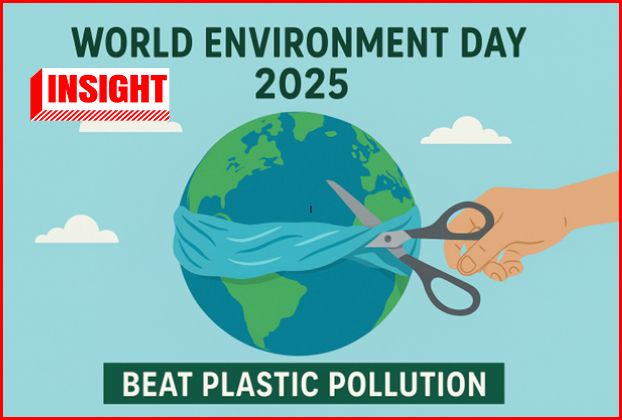Subscribe to our WhatsApp Channel
For many decades, Plastic pollution has been taking place all around the world, affecting the water we drink, food we eat and our bodies. Environmentalists point out that while plastic pollution is a major problem, it is still one of the most solvable environmental challenges, and that there are several solution that can be taken to it.
The 2025 World Environment Day focuses on the theme “Ending Global Plastic Pollution”, and the global celebrations will be hosted by the Republic of Korea.
This year’s World Environment Day, has joined forces with the United Nations Environment Programme, to beat Plastic Pollution (#BeatPlasticPollution), implement sollutions, and advocate for it. It will focus on the growing scientific evidence on the impacts of plastic pollution and on the 5 concepts of refuse, reduce, reuse, recycle and rethink plastic use. This also helps to reaffirm the commitment to the 2022 global agreement to end plastic pollution through a global plastic pollution treaty.
Globally, an estimated 11 million tons of plastic waste leaks into aquatic ecosystems each year, and microplastics accumulate in soil from waste and landfills due to the use of plastics in agricultural products. The annual social and environmental costs of plastic pollution are estimated at between 300 and 600 billion US dollars.
This year’s World Environment Day celebrations come as countries make progress in securing a global agreement to end plastic pollution, including in the marine environment. In November 2024, the Republic of Korea hosted the fifth negotiation session to develop a plastic pollution treaty. The second part of the session is scheduled to be held in Geneva, Switzerland, from August 5 to 14.
Host Country
This is the second time that the Republic of Korea has hosted global observances for World Environment Day. The day was first celebrated in 1997 under the theme “For Life on Earth.”
Over the past 28 years, Korea has made remarkable progress in improving water and air quality, safely managing chemicals, and protecting and restoring ecosystems. Today, building on decades of experience engaging business through extended producer responsibility, the Republic of Korea is among the countries that prioritize combating plastic waste. Their strtegy aims to find solutions for every stage of life cycle of plastics, from production and designing to consumption, reuse and recycling. By curbing waste, expanding recycling efforts, and accelerating the transition to a circular economy, the Republic of Korea is taking decisive action to reduce plastic pollution and build a more sustainable future. More information here.
Nearly 250,000 tons of plastic waste is disposed of in Sri Lanka annually. About 11 kg of plastic is disposed of per person per year, and only 11% of this is recycled. Even though food packaging materials such as sheets, tubes, and polythene are banned by law, they are still found in stores.
Nissanka de Silva, founder of the Zero Plastic Movement, pointed out that although laws exist in this country, implementation is lacking. He also states that the use of environmentally friendly alternatives to plastic is a fundamental solution to reducing plastic pollution.
Are you aware of the codes of plastic products you use?
We all use plastic in various forms, such as bottles, containers, packaging, bags. Many plastic products have a small triangle with a number on it that many people ignore. The number indicates the type of plastic that is used in the product and whether it is safe or recyclable.
These symbols are called Resin Identification Codes (RIC). They range from #1 to #7. Let’s take a look at what each symbol means.
| Code | Product | Is it recyclable? | Is it safe? |
| #1 – PET or PETE | Water and Soft Drink bottles | (√) To use only once | Can release chemicals if reused |
| #2 – HDPE | Plastic jugs, shampoo bottles | (√) | Srtong and safe |
| #3 – PVC | Pipes, Cling wraps, and Toys | (X) | Contains harmful chemicals |
| #4 – LDPE | Grocery bags, bread bags | (√) | Flexible but not always recyclable |
| #5 – PP | Yogurt cups, Medicine bottles | (√) | Srtong, Heat resistant |
| #6 – PS (Polystyrene) | Plastic cups, Food packaging boxes | (X) | Toxic chemicals can be leaked |
| #7 – Other | Mixed plastics (Baby bottles, Sunglasses) | Depends on product | Mostly not recycled |
American Chemistry Council. Plastic Packaging Resins.,The Balance: Small Business.Recycling Polyethylene Terephthalate (PET).,Enkay ,plasticactioncentre
Are these codes relevant to Sri Lanka?
Plastic products such as water bottles, food packaging, buckets, etc. manufactured or imported in Sri Lanka generally use symbols with numbers from #1 to #7. These symbols, developed by the Society of the Plastics Industry (SPI) in the United States, are based on international plastic classification standards and are used worldwide, including in Sri Lanka.
Some projects encourage the collection and recycling of PET (#1) and HDPE (#2) types of plastic. Materials such as PVC (#3) and PS (#6) are sent for industrial destruction due to their hazardous nature. More information here.
Sri Lanka’s plastic material management policies also adopt these codes.
The National Plastic Waste Management Action Plan, which commenced in 2021 and will be processed until 2030, encourages people to be more aware of the types of plastic they use.
Recognized programs have also been implemented to train school children and families on how to use these symbols on plastic products to sort their waste.
You will understand that there is no solution to this problem unless you understand the types of plastic that you use and the harm they cause to the environment.
In Sri Lanka, the Central Environmental Authority (CEA) states that nearly 1,6 million pieces of plastic waste are disposed of every day. Only a small percentage of it is actually recycled, so most of it ends up in the environment, floating in rivers, streams, or oceans, or being burned.
Media reports indicate that microplastics have already been detected in drinking water consumed by humans and in fish consumed as food.
Many plastic products are manufactured to be easily digestible, but in reality they break down into very small particles and do not undergo complete biological degradation.
Therefore, partially degradable plastic products are more harmful to the environment than non-degradable bulk plastic products.
The tiny plastic particles that remain are carried from the soil through streams and rivers to the ocean. Ultimately, the tiny plastic particles in ocean water and rivers enter the human body throught the filter feeding of microorganisms (zooplankton, ichthyoplankton), in the water.
There is a risk that these microorganisms will often mistake these microplastic particles for very small food particles and ingest them.
Microorganisms containing small plastic particles are eaten by small fish (fish larvae), which then enter the fish’s bodies. These microplastic particles travel through this food chain and eventually enter the human body.
These small plastic particles can also easily lodge in the bodies of ocean filter feeders. Bivalve, Scallop, often considered as shellfish, easily accumulate plastic particles in their bodies and can be ingested by human during consumption.
It is also said that even the salt and other marine products that we often consume may contain these microplastic particles. More information here and here.
This is not only an environmental problem, but it also extends to health problems and economic problems for generations. While keeping plastic use to a minimum, with an understanding of what plastic materials we use today and the harm they cause, let us join hands with one aim to protect the environment on the World Environment Day, with the responsibility to work for the well-being of all living beings, both humans and animals !

Title:To put an end to the Plastic Pollution, you should know about the severity of the plastic around you !
Fact Check By: Factcrescendo TeamResult: Insight






